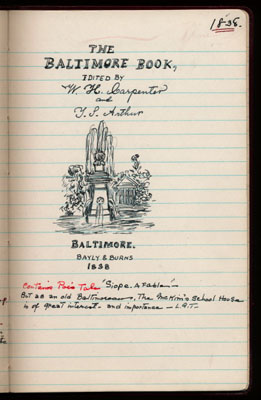Collecting Journals: Volume IV, 1835-1840
The fourth collecting journal contains several interesting comments on collecting, as well as a handful of entries that reveal Lillian’s excitement for obtaining and caring for her more rare books.
One insightful comment comes as she assesses the divide between popular literature and literary merit that emerges through time. Writing in 1944, Lillian reflects on Caroline Gilman’s 1840 Love’s Progress: “Fine condition, but dull reading!! […] 100 years hence will the books of 1944 be classed dull? Now I blush to add to this collection, the titles of some of our best sellers. Shocking in taste and morals. Love has progressed since 1840.” An amusing reflection arises in her entry on James Birchett Ransom’s Osceola, where she writes of his signature in the presentation copy, “I will not attempt to copy the bold, blotted writing. The ink has gone through the opposite blank page, and slightly spotted the frontispiece. […] I think Mr. Ransom had had a big mint julip [sic] before autographing my copy. He left the ‘O’ out of Osceola, and wrote it in above the name.”
Lillian’s concern about the physical state of her books appears again, as she writes of repairing Robert Montgomery Bird’s Sheppard Lee. She states, “Some foxing. 1 End. paper of Vol. II out. Labels have fed hungry roaches. I will replace Vol. I’s label with my own work.” This shows once again that she was interested not only in collecting and researching her books, but also worried about caring for their condition.
Of the books recorded in this volume, Lillian was particularly excited to acquire William Gilmore Simms’s The Yemassee; Robert Burts’s The Scourge of the Ocean; and Edgar Allan Poe’s Tales of the Grotesque and Arabesque. Of The Yemassee, she writes, “A beautiful clean, crisp copy. The labels scratched and a hole in the centre of the first end paper of Vol. I. I had been seeking a good copy. Then saw this in a catalogue, and telegraphed for it, in spite of ‘price $100!’ It is easily worth it, for it is a presentation copy, and as such is both rare and desirable.” She cherished her 1837 copy of The Scourge of the Ocean as the sole one reported in Wright’s bibliography; he had sent out a questionnaire listing an only 1847 Scourge. And Lillian clearly treasured her copy of Tales of the Grotesque and Arabesque, which was a Christmas gift from her husband. It was also one of the more costly acquisitions in her collection, costing Bob $375 back in 1936.

